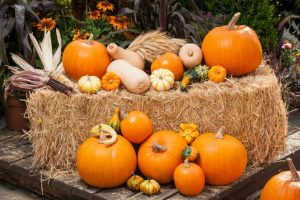Pumpkins are a highly nutritious vegetable and very versatile when it comes to cooking them. There are any number of preparations you can make with them including salads, soups, cookies, and breads. Should you stop by at your local Starbucks, you could even find the Pumpkin Spice Latte. Pumpkins are packed with nutrients, easy to digest, and can be eaten in the raw or cooked form. Of course, no Halloween decoration is complete without the quintessential carved pumpkin lantern. If you’ve been thinking about growing your own vegetables, here’s a quick lesson on how to plant pumpkin seeds.
Time Frame for Growing Pumpkins
To grow a decent-sized pumpkin, expect that the plant will take around 70 to 100 days to mature and produce ripe fruit. The plants also need lots of sunshine without any frost. When understanding how to plant pumpkin seeds, you’ll learn that it is best to sow the seeds by the end of May if you live in the northern states. But, if you’re located in the southern states, planting the seeds by the beginning of July would be perfect. The soil should be warm enough in these months for the plant to grow without rotting.
How to Plant Pumpkin Seeds
Best Conditions for Growing Pumpkins
The pumpkin plant needs careful care for growing and maturing. To begin with, you’ll need to choose a spacious plot of land with plenty of room for the vines to grow. The soil should be rich with plenty of nutrients but well-drained. If the soil is warm enough at a minimum of 70ºF, you can sow the seeds directly into the ground. But, if the weather is cool, grow the seeds indoors in peat pots for around 2 to 4 weeks so they start to germinate before you transfer them into the ground.
Preparing the Soil and Site for the Pumpkin Vines
Build small hills with soil to the size of pitcher mounds in rows spaced at distances of 4 to 8 feet from each other. Enrich the soil with lots of compost and aged manure layered 12 to 15 inches in the ground. The hills will help maintain the temperature at around 95ºF which is just right for the plants to grow. They’ll also keep away excess moisture and pests. You can plant 4 to 5 seeds into each mound or place the germinated seeds into them.
Caring for the Pumpkin Plants
With the right temperature and soil conditions, you can expect to see the plant shoots emerge from the ground within a couple of weeks. Seasoned pumpkin growers will advise you to wait until the plants are 2 to 3 inches in height and then allow just 2 or 3 saplings to remain on each mound. Remove the others by snipping them at ground level without disturbing the roots of the ones you want to keep. Each week, water one inch, but take care to avoid pouring on the fruit or stems and leaves. Once the plants are about a foot tall, fertilize with a product containing nitrogen. And, just before the flowers bloom, add a fertilizer rich in phosphorus.
Managing the Flowers and Fruit
When the blooms start to open, you’ll see both male and female flowers. This is a good time to encourage visits from bees that will pollinate the flowers. Take care to use insecticides and pesticides only in the late afternoon or early evening. That’s when the flowers have closed for the day and bees are unlikely to visit them. Once you start to see a few pumpkins forming, prune the tips of the plant so that the plant is focused on growing the existing fruit in size. Pumpkins have shallow roots, so when loosening the soil, make sure you don’t damage them. As the fruit grows in size, turn every now and then so you get a lovely round shape.
Once the season is over, you can save the seeds that are likely to keep for at least 6 years.


